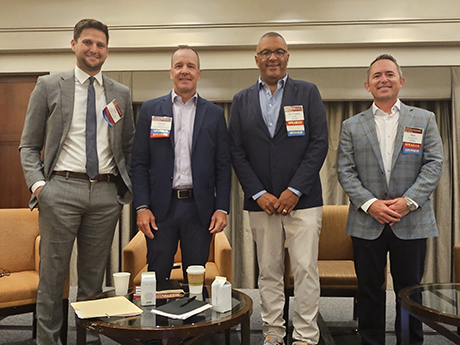By Matt Valley
The seniors housing lending market hasn’t made a 180-degree turn from a year ago when the Federal Reserve was at the peak of its monetary tightening cycle, Fannie Mae and Freddie Mac were dealing with plenty of asset management issues on their balance sheets and the loan underwriting practices of banks were quite stringent.
But the debt financing market has clearly turned a corner and is headed in the right direction, even as developers remain frustrated. That is one of the big takeaways from InterFace Seniors Housing Midwest in Chicago.
“The Fed has started to cut interest rates, albeit pretty slowly. The agencies (Fannie Mae and Freddie Mac) are back looking for new deals. HUD is still active,” said Josh Vander Plaats, managing director with VIUM Capital, during the capital markets panel he moderated at InterFace Seniors Housing Midwest. The daylong conference, which took place June 25 at the Swisshotel Chicago, attracted 215 attendees.
Joining Vander Plaats on stage for the capital markets discussion were Tyler Armstrong, managing director at Lument; Christopher Ellis, senior director of originations, Nuveen Green Capital; and Charlie Shoop, senior vice president of healthcare mortgage banking, KeyBank Real Estate Capital
The mood a year ago at the same conference was decidedly less upbeat, Vander Plaats noted. “It wasn’t all doom and gloom, but I would say that it was a challenging lending environment for seniors housing.”
There’s also anecdotal evidence to back his claim of renewed optimism. “We came back from the American Seniors Housing Association’s Mid-Year Meeting (held at the Omni Interlocken in Broomfield, Colorado) a few weeks ago. The overwhelming consensus was everybody’s lending,” emphasized Vander Platts.
The session moderator asked panelists to provide their observations on what types of deals are getting done today and how the lending environment has changed over the last six to 12 months.
“It’s been a long slog getting through COVID and post-COVID, and now we can finally see some light at the end of the tunnel,” said Shoop of KeyBank Real Estate Capital.
Banks are healthier today than they were a few years ago and have cleaned up their portfolios, he noted. In 2023, there were five bank failures — Silicon Valley Bank, Signature Bank, First Republic Bank, Silvergate Bank and Heartland Tri-State Bank. The Office of the Comptroller of the Currency clamped down on banks at that time to prevent unsafe or unsound lending practices.
Meanwhile, the fundamentals of seniors housing are getting stronger almost by the quarter, noted Shoop, referring to occupancy gains and less reliance on high-cost agency staffing.
The occupancy rate for majority independent living and assisted living properties across the 31 primary markets tracked by NIC MAP was 88.1 percent in the second quarter, up 80 basis points from the prior quarter.
“We’re looking at deals now where NOIs (net operating incomes) are positive and there is in-place cash flow coverage, which has always been the big focus for lenders.”
Shoop said he’s encountered plenty of financing activity not only on the bank side, but also among life insurance companies and government-sponsored enterprises Fannie Mae and Freddie Mac. The bottom line is that it’s clearly a more competitive market today than even a year ago.
“Freddie Mac came back with a five-year product where it will do some flexible prepayment on a five-year term,” said Shoop.
In a follow-up email to Seniors Housing Business, Shoop explained that Freddie calls the loan product a “flex prepay” structure. “They stopped quoting that for seniors housing post-Covid for a few years but recently reinstituted it and have had some success, primarily with mid-term real estate holders like private equity funds who may not have 10 years of fund maturity remaining, or for those who have sale aspirations within a mid-term period.”
Banks are also stepping up and doing five-year loan terms. “That seems to be the sweet spot for borrowers,” Shoop told the audience, noting that with the possibility of lower interest rates down the road borrowers want to “just keep things mid-term versus the long-term, 10-year deal.”
Many private equity and fund-backed sponsors value the prepayment and sale flexibility in the event they want to sell and not be subject to yield maintenance prepayment penalties, explained Shoop in his follow-up email.
Sponsor, location matter
Armstrong contextualized his response on what’s changed in the seniors lending space this year by pointing out that Lument wears a few different hats. As a direct lender, Lument is licensed with Fannie Mae and Freddie Mac. It also provides HUD loans. Lument has the financial backing of its parent company, Orix Corp. USA.
Much of Lument’s business is debt advisory and broader bank placements, according to Armstrong. “In that work, we are looking for the best execution for our clients, whether it be on our balance sheet or broadly wherever it best fits.” In his view, the lending market is in a much better place than it was a year or two ago.
The Lument team talks regularly with banks, so it has its finger on the pulse of what’s happening in their world. “It certainly feels like bank pricing continues to get tighter and tighter, which is great for clients,” said Armstrong.
“I still think there’s a flight to quality. Sponsorship, location of the asset (plus quality of the asset) — these kinds of things always continue to matter no matter the market. But we’ve seen pricing come in, generally across the board, and things have become more competitive.”
Stabilized assets in need of financing are in the catbird seat, pointed out Armstrong. “You’re going to have every lender interested, including life company lenders, agency lenders and certainly banks.”
C-PACE lender rides momentum
As senior director of originations with Nuveen Green Capital, Ellis covers the Midwest territory for the company, which is a national lender in sustainable commercial real estate financing. The company specializes in Commercial Property Assessed Clean Energy (C-PACE) financing.
C-PACE provides flexible financing solutions for new, ongoing, or recently completed commercial real estate projects. Available in 40 states and Washington D.C., C-PACE has grown in popularity in the commercial real estate market as an attractive financing mechanism.
A C-PACE loan is repaid through property tax assessments, not through traditional monthly loan payments. The loan is structured as a special assessment on the property, which is collected alongside regular property taxes.
“We’re mainly involved with new construction [projects] and some bridge financing. We’re seeing more opportunities there. We just closed a deal in Wisconsin a few weeks ago,” said Ellis.
“We’ve got a couple of deals happening now in Texas and Tennessee, and a few in Ohio. So, we’re setting shovels getting into the ground now.”
Earlier this year, Nuveen Green Capital provided $10.6 million in C-PACE financing for the construction of a new senior living development in Sheboygan, Wisconsin. North Town Partners was the borrower.
Upon completion, Charter Senior Living Sheboygan will total 182 independent living, assisted living and memory care units within a 191,000-square-foot building.
Charter Senior Living Sheboygan is being developed jointly by DMK Development Group, North Town Partners and Charter Senior Living. The project’s total cost is $55 million.
“We’re seeing people get more aggressive to do construction deals. Local regional banks are playing. We’ve done a few [deals] with debt funds, and we’ve actually seen some Canadian groups come down and start funding new construction,” said Ellis.
Vander Plaats pointed out that developers at the conference expressed their excitement at wanting to bring more new supply to the market because it’s desperately needed, but they’re having a difficult time finding capital partners. He asked Ellis what banks are lending in the construction space.
“Live Oak Bank is one that we’ve partnered with a couple of different times. The deal in Wisconsin that we just closed was with CIBC. So, it’s that local, regional bank. We’ve also closed deals with a few debt funds recently. Again, we don’t really play with the agencies on the permanent side. It’s usually more on the construction side,” said Ellis.
“We’ve had a couple deals where they’re still trying to get the full LP capital raised, and those have dragged out some [projects]. But over the last probably six to nine months we think that side has picked up a bit more,” said Ellis.
“LP capital raised” refers to the total amount of money contributed by limited partners to a real estate investment or project. The LPs are the passive investors who provide the financial backing for a deal.
Lument’s Armstrong agreed that securing LP capital is the name of the game. “It’s been very difficult for most developers, who are kind of going to the market if you will, to find their equity. That’s been a challenge because that equity can buy [properties] below replacement cost. You continue to hear that, and that’s kind of what their charge has been.”
Armstrong said Lument has had clients seeking to develop entitled land that the client had been sitting on for a while and that it wanted to monetize, but the LP capital just wasn’t there for them.
“If you have clients that you know have potentially captured sort of programmatic equity with institutional partners or high-net-worth individuals — or they bring their own money to the table — we’ve seen development,” said Armstrong. “But that’s so unique.”

